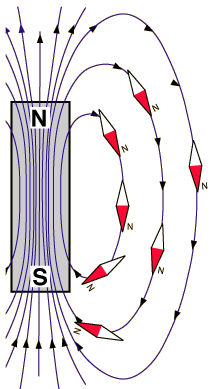Magnet
Revision as of 16:56, 12 August 2015 by J.williams (talk | contribs)

Figure 1: A bar magnet, with labelled north and south poles.[1]

Figure 1: The magnetic field of a bar magnet, with the direction of the field pointing from North to South as shown by the compass needle.[2]
A magnet is a type of material that produces a magnetic field. The magnetic field produced is invisible, but its effects are felt very easily when put in contact with other magnetic materials.
A magnet is characterized by its two poles; North and South. These poles create a magnetic field that flows from the North to the South pole, and can be depicted by a compass needle as shown in Figure 2. A compass needle is actually a permanent magnet, and naturally orients itself to align with any magnetic field.[2]
The ability for a material to respond to a magnetic field is discussed in more depth on hyperphysics.
Types of Magnets
There are 3 types of magnets:[3]
- Permanent magnets, typically called ferromagnetic, are materials that do not easily lose their magnetism once they are magnetized. Materials can be magnetized by coming into contact with an external magnetic field. This process can be accelerated by first heating and then cooling the material. Such materials are also referred to as hard magnets.[4] Permanent magnets are often used in wind turbines.
- Temporary magnets are very easily magnetized (by an external field), but tend to lose their magnetism gradually over time. These magnets are also referred to as soft magnets.[4]
- Electromagnets are very strong magnets, used in devices such as computers, televisions and motors. They are made by placing a metal core inside a coil of wire that is carrying an electrical current. The electricity going through the wire produces a magnetic field. While the electric current is flowing, the core acts as a strong magnet.[3] Electromagnets are used in many generators and power plants.
References
- ↑ Wikimedia Commons [Online], Available: http://upload.wikimedia.org/wikipedia/commons/d/d8/Bar_magnet.jpg
- ↑ 2.0 2.1 Hyperphysics, Magnets and Electromagnets [Online], Available: http://hyperphysics.phy-astr.gsu.edu/hbase/magnetic/elemag.html
- ↑ 3.0 3.1 Home Science Tools, Types of Magnets [Online], Available: http://www.hometrainingtools.com/a/magnet-types-science-teaching-tip
- ↑ 4.0 4.1 R. Serway and C. Vuille, "Magnets" in Essentials of College Physics [Online], Available: http://books.google.ca/books?id=8n4NCyRgUMEC&pg=PA493&redir_esc=y#v=onepage&q&f=false

